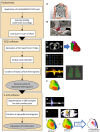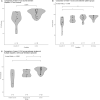Ventricular Conduction Stability Noninvasively Identifies an Arrhythmic Substrate in Survivors of Idiopathic Ventricular Fibrillation
- PMID: 37042261
- PMCID: PMC10227238
- DOI: 10.1161/JAHA.122.028661
Ventricular Conduction Stability Noninvasively Identifies an Arrhythmic Substrate in Survivors of Idiopathic Ventricular Fibrillation
Abstract
Background Idiopathic ventricular fibrillation (VF) is a diagnosis of exclusion following normal cardiac investigations. We sought to determine if exercise-induced changes in electrical substrate could distinguish patient groups with various ventricular arrhythmic pathophysiological conditions and identify patients susceptible to VF. Methods and Results Computed tomography and exercise testing in patients wearing a 252-electrode vest were combined to determine ventricular conduction stability between rest and peak exercise, as previously described. Using ventricular conduction stability, conduction heterogeneity in idiopathic VF survivors (n=14) was compared with those surviving VF during acute ischemia with preserved ventricular function following full revascularization (n=10), patients with benign ventricular ectopy (n=11), and patients with normal hearts, no arrhythmic history, and negative Ajmaline challenge during Brugada family screening (Brugada syndrome relatives; n=11). Activation patterns in normal subjects (Brugada syndrome relatives) are preserved following exercise, with mean ventricular conduction stability of 99.2±0.9%. Increased heterogeneity of activation occurred in the idiopathic VF survivors (ventricular conduction stability: 96.9±2.3%) compared with the other groups combined (versus 98.8±1.6%; P=0.001). All groups demonstrated periodic variation in activation heterogeneity (frequency, 0.3-1 Hz), but magnitude was greater in idiopathic VF survivors than Brugada syndrome relatives or patients with ventricular ectopy (7.6±4.1%, 2.9±2.9%, and 2.8±1.2%, respectively). The cause of this periodicity is unknown and was not replicable by introducing exercise-induced noise at comparable frequencies. Conclusions In normal subjects, ventricular activation patterns change little with exercise. In contrast, patients with susceptibility to VF experience activation heterogeneity following exercise that requires further investigation as a testable manifestation of underlying myocardial abnormalities otherwise silent during routine testing.
Keywords: exercise testing; idiopathic ventricular fibrillation; myocardial ischemia; premature ventricular complex.
Figures





References
-
- Haïssaguerre M, Duchateau J, Dubois R, Hocini M, Cheniti G, Sacher F, Lavergne T, Probst V, Surget E, Vigmond E, et al. Idiopathic ventricular fibrillation: role of purkinje system and microstructural myocardial abnormalities. JACC Clin Electrophysiol. 2020;6:591–608. doi: 10.1016/j.jacep.2020.03.010 - DOI - PMC - PubMed
-
- Cluitmans MJM, Bear LR, Nguyên UC, van Rees B, Stoks J, Ter Bekke RMA, Mihl C, Heijman J, Lau KD, Vigmond E, et al. Noninvasive detection of spatiotemporal activation‐repolarization interactions that prime idiopathic ventricular fibrillation. Sci Transl Med. 2021;13:eabi9317. doi: 10.1126/scitranslmed.abi9317 - DOI - PubMed
-
- Leoni AL, Gavillet B, Rougier JS, Marionneau C, Probst V, Le Scouarnec S, Schott JJ, Demolombe S, Bruneval P, Huang CL, et al. Variable Na(v)1.5 protein expression from the wild‐type allele correlates with the penetrance of cardiac conduction disease in the Scn5a(+/−) mouse model. PLoS One. 2010;5:e9298. doi: 10.1371/journal.pone.0009298 - DOI - PMC - PubMed
Publication types
MeSH terms
Supplementary concepts
Grants and funding
LinkOut - more resources
Full Text Sources

